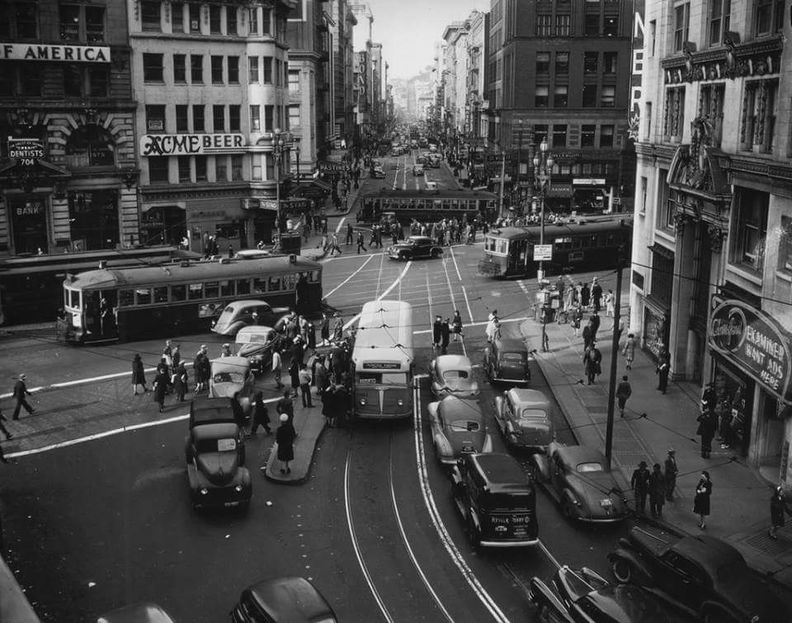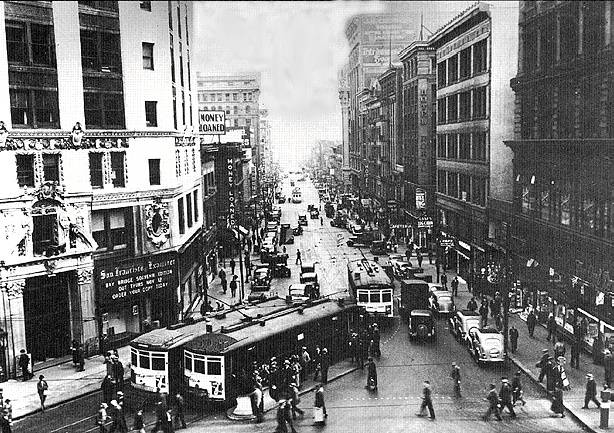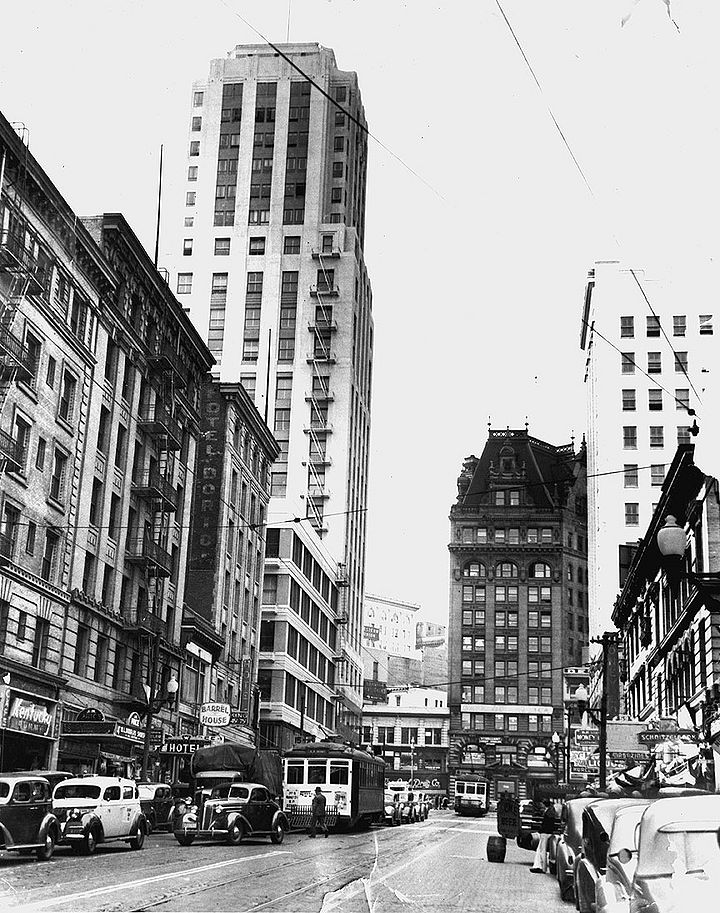3rd Street Streetcar Lines: Difference between revisions
(transit tour stop and PC) |
(added photo) |
||
| (10 intermediate revisions by 3 users not shown) | |||
| Line 2: | Line 2: | ||
''by Anne B. Bloomfield'' | ''by Anne B. Bloomfield'' | ||
[[Image:3rd and Market c 1940s.jpg|792px]] | |||
'''3rd and Market, c. 1940s.''' | |||
''Photo: Facebook download'' | |||
[[Image:soma1$3rd-steet-looking-south-1936.jpg]] | [[Image:soma1$3rd-steet-looking-south-1936.jpg]] | ||
| Line 8: | Line 14: | ||
''Photo: San Francisco History Center, San Francisco Public Library'' | ''Photo: San Francisco History Center, San Francisco Public Library'' | ||
[[Image:Streetcar-Traffic-View-from-Above-on-Market-Street-Looking-East-from-Kearny-at-5-PM March-20-1940 D4279.jpg]] | |||
'''Streetcar traffic in 1940, the "Roar of the Four" era, seen here from Kearny/3rd looking east on Market.''' | |||
''Photo: C.R. Collection'' | |||
It was still an age of public transportation. By 1913 all the pre-fire transit lines south of Market had been rebuilt, with electric power. They included routes that dated back to or beyond the early 1860s, along Howard, Folsom, and three of the numbered streets. The Mission Street route had commenced by 1871. | It was still an age of public transportation. By 1913 all the pre-fire transit lines south of Market had been rebuilt, with electric power. They included routes that dated back to or beyond the early 1860s, along Howard, Folsom, and three of the numbered streets. The Mission Street route had commenced by 1871. | ||
Two more parallel and several numbered streets acquired streetcar lines about 1890. The number of lines reflected the density of population south of Market in the nineteenth century and funneled workers and customers into the downtown from outlying residential areas, including San Mateo County via Southern Pacific steam trains. The redundant routes had been established by competing companies, but were gathered into United Railroads by 1902. This company rebuilt them all after 1906, and the company, renamed the Market Street Railway, maintained them until around 1940. Some of the routes still run today, now under municipal operation.60 | Two more parallel and several numbered streets acquired streetcar lines about 1890. The number of lines reflected the density of population south of Market in the nineteenth century and funneled workers and customers into the downtown from outlying residential areas, including San Mateo County via [[Trains in the Mission|Southern Pacific steam trains]]. The redundant routes had been established by competing companies, but were gathered into [[United Railroads|United Railroads]] by 1902. This company rebuilt them all after 1906, and the company, renamed the Market Street Railway, maintained them until around 1940. Some of the routes still run today, now under municipal operation.60 | ||
--from "A History of the California Historical Society's New Mission Street Neighborhood" by Anne B. Bloomfield in ''California History'' magazine, Winter 1995/96 | --from "A History of the California Historical Society's New Mission Street Neighborhood" by Anne B. Bloomfield in ''California History'' magazine, Winter 1995/96 | ||
[[Image: | [[Image:3rd-St-north-from-Jessie-St-Call-Bldg-and-Nos-15-16-and-29-streetcars-April-18-1939-SFPL.jpg|720px]] | ||
'''3rd Street north from Jessie Street, April 18, 1939. [[THE CALL BUILDING: SAN FRANCISCO'S FORGOTTEN SKYSCRAPER|Call Building]] is tall structure at back left. Streetcars #s 15, 16, and 29 ran along Third Street in this period.''' | |||
''Photo: San Francisco History Center, San Francisco Public Library, courtesy C.R. collection'' | |||
[[1906 FIRE AND AFTERMATH |Prev. Document]] [[traffic jam 1946 |Next Document]] | [[1906 FIRE AND AFTERMATH |Prev. Document]] [[traffic jam 1946 |Next Document]] | ||
[[category:SOMA]] [[category:Transit]] [[category:1900s]] [[category:1910s]] [[category:1930s]] [[category:1890s]] [[category:1870s]] | [[category:SOMA]] [[category:Transit]] [[category:1900s]] [[category:1910s]] [[category:1930s]] [[category:1890s]] [[category:1870s]] [[category:1940s]] | ||
Latest revision as of 19:08, 4 September 2020
Historical Essay
by Anne B. Bloomfield
3rd and Market, c. 1940s.
Photo: Facebook download
Looking south down 3rd Street from Market c. 1936.
Photo: San Francisco History Center, San Francisco Public Library
Streetcar traffic in 1940, the "Roar of the Four" era, seen here from Kearny/3rd looking east on Market.
Photo: C.R. Collection
It was still an age of public transportation. By 1913 all the pre-fire transit lines south of Market had been rebuilt, with electric power. They included routes that dated back to or beyond the early 1860s, along Howard, Folsom, and three of the numbered streets. The Mission Street route had commenced by 1871.
Two more parallel and several numbered streets acquired streetcar lines about 1890. The number of lines reflected the density of population south of Market in the nineteenth century and funneled workers and customers into the downtown from outlying residential areas, including San Mateo County via Southern Pacific steam trains. The redundant routes had been established by competing companies, but were gathered into United Railroads by 1902. This company rebuilt them all after 1906, and the company, renamed the Market Street Railway, maintained them until around 1940. Some of the routes still run today, now under municipal operation.60
--from "A History of the California Historical Society's New Mission Street Neighborhood" by Anne B. Bloomfield in California History magazine, Winter 1995/96
3rd Street north from Jessie Street, April 18, 1939. Call Building is tall structure at back left. Streetcars #s 15, 16, and 29 ran along Third Street in this period.
Photo: San Francisco History Center, San Francisco Public Library, courtesy C.R. collection




